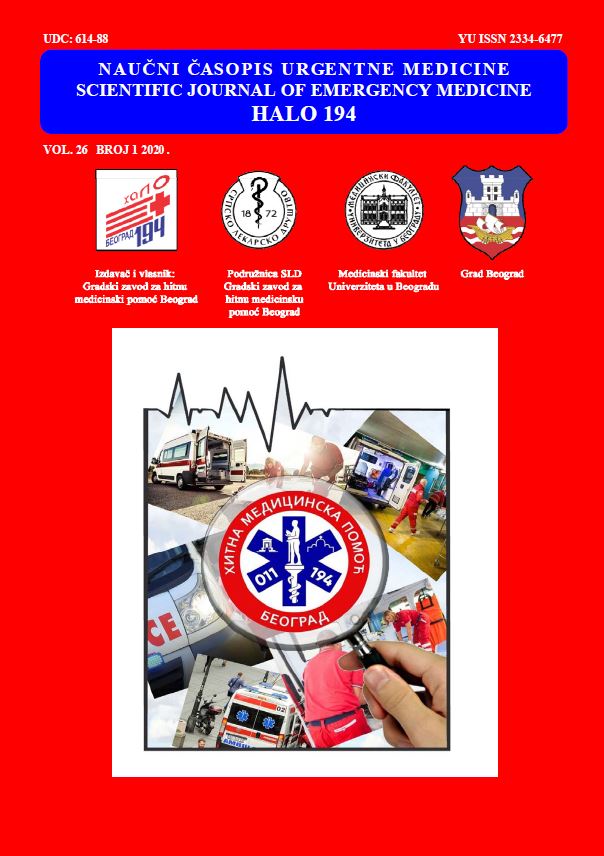THE IMPORTANCE OF PREHOSPITAL RECOGNITION OF ST SEGMENT ELEVATION IN THE AVR LEAD IN ACUTE CORONARY SYNDROME
Abstract
Objective The objective of the article is to present how educated the EMS doctors included in the STEMI network are in recognizing and treating the aVR lead elevation, as an atypical ECG finding.
Case report Three patients with chest pain from 30 minutes to 2.5 hours are presented. The ECG recording sST depressions >1mm in 6 or more leads (I, II, III, aVL, aVF, V2-V6) coupled with a 3-4mm ST elevation in the aVR lead and similar less pronounced ST elevation in V1. The strategy for primary PCI had been initialized, after consultation with interventional cardiologists and having taken the initial dose of dual antiplatelet therapy, transported to the hospital catheterization labs.
Conclusion ST segment depression of 1 mm or more in six or more leads (inferolateral depression) coupled with ST segment elevation in aVR and/or V1 points to the three-vessel disease (3VD) or left main coronary artery (LMCA) obstruction.
References
2. Sgarbossa EB, Pinski SL, Barbagelata A, Underwood DA, Gates KB, Topol EJ, et al. Electrocardiographic diagnosis of evolving acute myocardial infarction in the presence of left bundle-branch block. GUSTO-1 (Global Utilization of Streptokinase and Tissue Plasminogen Activator for Occluded Coronary Arteries) Investigators. The New England journal of medicine. 1996;334(8):481–487. DOI: 10.1056/NEJM199602223340801.
3. Rostoff P, Piwowarska W, Gackowski A, Konduracka E, El Massri N, Latacz P, et al. Electrocardiographic prediction of acute left main coronary artery occlusion Am J Emerg Med. 2007;25(7):852-585. PMID:17870500. DOI: 10.1016/j.ajem.2007.01.025.
4. Burns E. LMCA occlusion: ST Elevation in aVR.
5. Life in the fastlane. Last update March 16, 2019. Available from: https://litfl.com/lmca-occlusion-st-elevation-in-avr/. [Accessed 15th June 2015].
6. Ibanez B, James S, Agewall S, Antunes MJ, Bucciarelli-Ducci C, Bueno H, et al. 2017 ESC Guidelines for the management of acute myocardial infarction in patients presenting with ST-segment elevation. European Heart Journal. 2018; 39(2): 119–177. doi:10.1093/eurheartj/ehx393.
7. Nabati M, Emadi M, Mollaalipour M, Bagheri B, & Nouraei M. ST-segment elevation in lead aVR in the setting of acute coronary syndrome. Acta Cardiologica. 2016; 71(1): 47-54. PMID: 26853253. DOI:10.1080/AC.71.1.3132097.
8. Misumida N, Kobayashi A, Fox JT, Hanon S, Schweitzer P, Kanei Y. Predictive Value of ST-Segment Elevation in Lead aVR for Left Main and/or Three-Vessel Disease in Non-ST-Segment Elevation Myocardial Infarction. Ann Noninvasive Electrocardiol. 2016;21(1):91-97. PMID: 25884447. doi: 10.1111/anec.12272.
9. Ivanov I, Jarakovic M, Dejanovic J, Petrovic M, Srdanovic I, Obradovic D. Diagnostic and prognostic utility of avr lead inelectrocardiogram. Medicinski časopis. 2014; 48(2): 104-107. doi:10.5937/mckg48-4068.
10. Misumida N, Kobayashi A, Fox JT, Hanon S, Schweitzer P, Kanei Y. Predictive Value of ST-Segment Elevation in Lead aVR for Left Main and/or Three-Vessel Disease in Non-ST-Segment Elevation Myocardial Infarction. Ann Noninvasive Electrocardiol. 2016; 21(1): 91-97. DOI:10.1111/anec.12272
- Autori zadržavaju autorska prava i pružaju časopisu pravo prvog objavljivanja rada i licenciraju ga "Creative Commons Attribution licencom" koja omogućava drugima da dele rad, uz uslov navođenja autorstva i izvornog objavljivanja u ovom časopisu.
- Autori mogu izraditi zasebne, ugovorne aranžmane za neekskluzivnu distribuciju članka objavljenog u časopisu (npr. postavljanje u institucionalni repozitorijum ili objavljivanje u knjizi), uz navođenje da je članak izvorno objavljen u ovom časopisu.
- Autorima je dozvoljeno i podstiču se da postave objavljeni članak onlajn (npr. u institucionalni repozitorijum ili na svoju internet stranicu) pre ili tokom postupka prijave rukopisa, s obzirom da takav postupak može voditi produktivnoj razmeni ideja i ranijoj i većoj citiranosti objavljenog članka (Vidi Efekti otvorenog pristupa).

